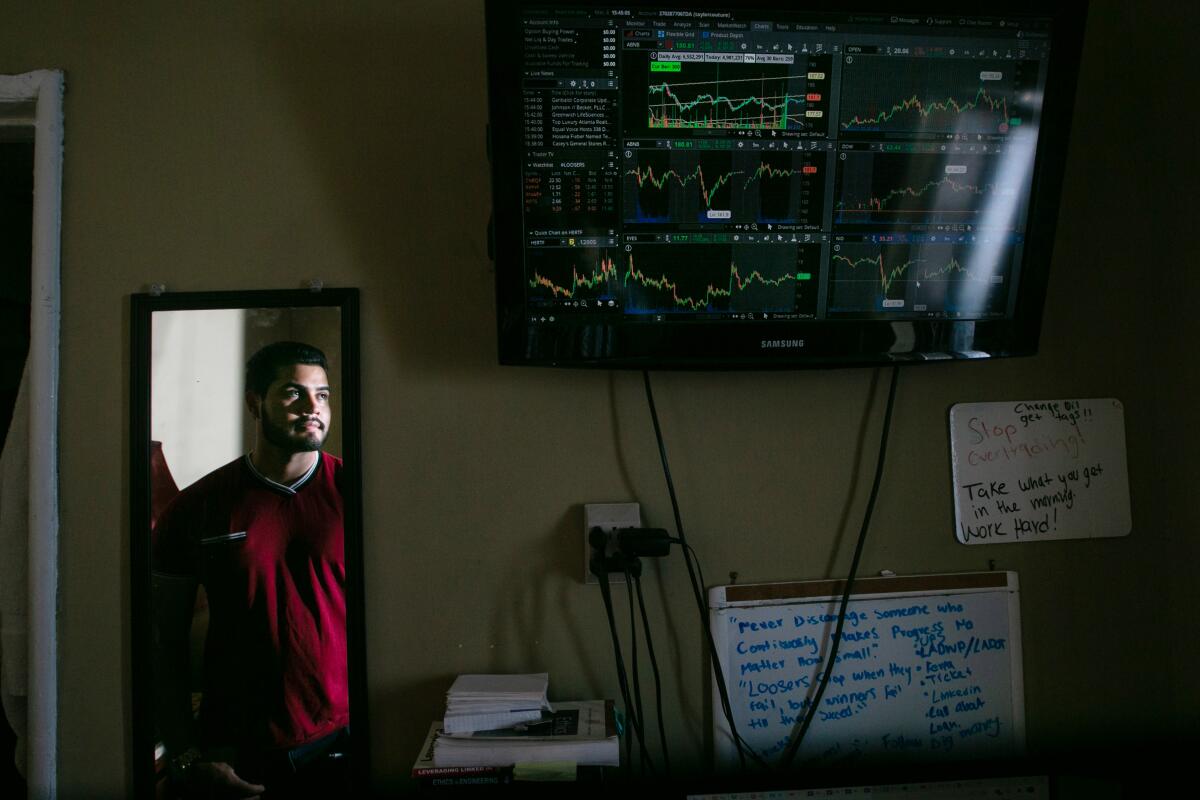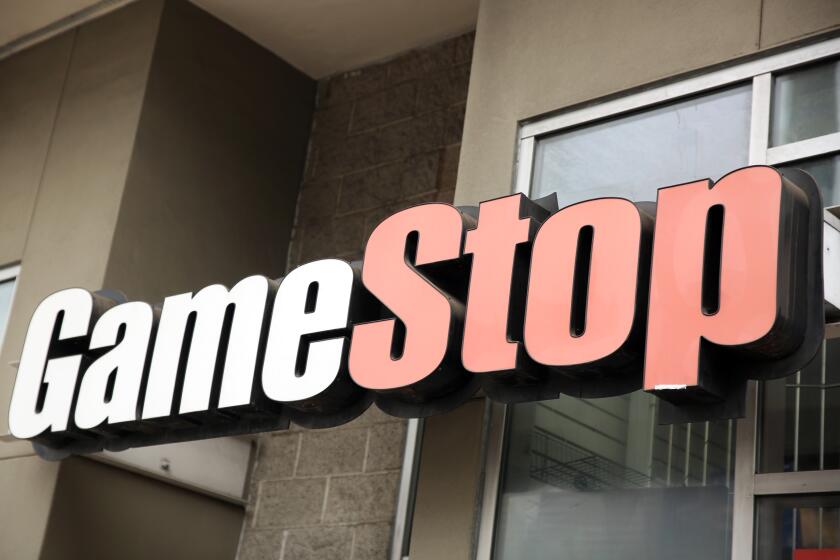Meet South L.A.’s young stock investors, eager to build wealth in their community

They’re comfortable with stock trading apps such as Robinhood and Webull, and they’re teaching themselves finance on the fly, hoping to score a stream of wins that propel themselves and their loved ones into a better life.
- Share via
At 1 a.m., the first alarm goes off. Blanca Lopez shakes off the sleep. For the last eight months, she’s been telling herself the same thing.
“I need to hustle. I’m so young, I need to make this money.”
For the record:
9:35 a.m. March 17, 2021An earlier version of this story said confetti appears on the Robinhood app whenever a user makes a transaction. It appears only on the first trade.
The 23-year-old South L.A. native, a case manager for a senior home, reaches for her iPhone and opens up Webull, an investing app that has surged in popularity since January. The app enables her to buy and sell stocks 5½ hours before the market opens for regular trading.
Sometimes she makes a trade this early in the day, but usually she just does research: Which stocks should she focus on today? How are their prices trending? Has any news broken that would make a company’s shares leap or plunge?
After 30 minutes, she’s ready to go back to bed. This was only a warmup.
Lopez is one of the many new investors nationwide who have delved into stocks during the COVID-19 pandemic. They are younger, more comfortable with trading apps and websites and come from a wider range of backgrounds than traditional stock investors.
The Latinx experience chronicled
Get the Latinx Files newsletter for stories that capture the multitudes within our communities.
You may occasionally receive promotional content from the Los Angeles Times.
In South L.A., some got into investing because they hope to buy a home. Several said their main motivation was to create generational wealth for their families and try to close the wealth gap between Black and Latino households and white households that exists in part because of unequal exposure to the stock market.
“We’re seeing a real lessening of some of the barriers that have caused folks to not be involved in stock market investing and this idea that you have to have $25,000, $50,000, $200,000 to engage with a financial professional,” said Angela Fontes, director of a team at research organization Norc at the University of Chicago that analyzes consumers’ behavior and economic decisions.
Day trading and other short-term investing strategies that capitalize on volatility are particularly risky. Even for seasoned professionals, each trade is a gamble; each chance to score a big win is also a chance to suffer a devastating loss. Pouring everything into such trades rather than funneling money into more sedate, longer-term investments might mean walking away with practically nothing.
In the last year, investors have been riding a wave of extraordinary stock-market conditions. After the market plunged and whipsawed early in the pandemic, it roared back upward and is now setting a slew of all-time highs. It will turn again at some point and punish the unlucky. But to some people, the risk feels worthwhile because they want a shot at a tremendous payout.
“There’s room in every portfolio to take on extra risk,” said Fernando Reyes, a Torrance-based certified financial planner at EP Wealth Advisors. “Everyone can take on a little bit more risk, obviously if they can afford to do so … but not with a huge portion of your wealth.”
Many of South L.A.’s young traders pursue longer-term investments as well as short-term bets. A common hope: that a steady stream of wins will propel them and their loved ones into a better life.
In 2004, Royer Levith Elvir and his family moved to the United States, fleeing violence in Honduras. He remembers growing up with very little money and says his family’s economic situation didn’t improve after they settled in Los Angeles.
“It’s always been on my head that if my parents brought me here when I was 7, I have to make something out of myself,” said Elvir, 23, who lives in Willowbrook and is the youngest of three brothers.
He’s a full-time electrical engineering student at Cal State L.A., but after he graduates and begins his engineering career, he’s going to want multiple streams of income.
“That’s why I’m trying to make it with the stock market,” he said. “I’m trying to create a difference in my family.”

Elvir wakes up at 4 a.m. to the sound of his alarm. In two steps, he goes from his bed to his desk, turns on the TV hanging above his workstation, opens his laptop and checks Finviz, a financial data and news aggregator. He has 2½ hours to do research before the stock market opens.
At 6 a.m., Lopez’s second alarm goes off. She makes a cup of coffee and moves into her office to narrow down the list of stocks she wants to trade, racing to finish before the clang of the New York Stock Exchange’s opening bell.
Trading in the early-morning premarket hours is light, so although stock prices at that time can provide clues about the day ahead, the picture can be distorted by just a handful of investors with offbeat opinions. When the stock market officially opens, bets flood in. The picture sharpens. Lopez and Elvir get a better sense of how well their trades will pay off, and they can choose to adjust their strategies or sit tight.
They don’t have very long to think about it. After making some trades, it’s time to shift their attention to their school and work obligations.
Since last summer, Lopez has been juggling a full-time job, online classes — she wants to be a nurse — and investing. During demanding work weeks, she takes it easy with her trades: “I make sure to not invest in stocks that can literally go up and down in seconds,” she said.
People like Lopez and Elvir found it easy to join the world of stock trading because several barriers to entry have been demolished.
As the internet grew, online brokerages popped up, enabling small investors to take trading into their own hands. The websites made transactions more accessible to people who couldn’t afford or didn’t want to open accounts with high minimums and pay for investment advisors.
Then came Robinhood. Founded in 2013, the Menlo Park fintech firm began offering no-commission stock trading through its app. By 2019, major brokerages had followed suit.
Some were just in it for the money. Others saw a chance to stick it to Wall Street. Between them, they made GameStop the latest symbol of chaotic internet-fueled change.
“It really opened a lot of doors for a lot of people to get into trading,” said Bryson Hill II, 23, who lives in Watts and has ramped up his use of Robinhood since the beginning of the pandemic. He trades in his free time, when he’s not working at his day job of scheduling surgeries at Kaiser Permanente. “You can start with a hundred bucks and you’re not paying all this money to trade.”
These changes, along with the ability to invest smaller amounts of money, a desire to save for retirement and the stock market’s wild swings in early 2020 — when the benchmark Standard & Poor’s 500 index plummeted 34% in barely more than a month, punctuated by a couple of single-day gains of more than 9% — encouraged a wave of new investors to start trading, a recent survey found.
More than half of survey respondents said they’d opened a new taxable investment account in 2020. Of those, about two-thirds were 45 years old or younger, with 22% aged 18 to 29, said the survey, published in February by the Financial Industry Regulatory Authority Investor Education Foundation and Norc at the University of Chicago.
Almost 60% of these new investors were white, 17% were Black, 15% were Latino and 10% were Asian. Compared with nationwide population figures, white and Latino investors were slightly underrepresented, while Black and Asian investors were overrepresented.
Part of that diversity is due to the rising popularity of online trading apps, experts say.
Since March 2020, the Robinhood app has been installed 17.7 million times worldwide, an increase of 157% compared with the same time period a year earlier, according to research firm Sensor Tower. During that same period, Chinese-owned trading app Webull was installed 6.6 million times, up 371%.
Robinhood caters to first-time investors — half its new customers this year were first-time stock investors, and the median user age is 31, the company said. The company says 19% of its customers are Latino, 10% are Asian and 9% are Black.
The company said it wants to make talking about finances less taboo.
“A lot of people learn by participating,” said Gretchen Howard, Robinhood’s chief operating officer. “When you hear people you know are starting to participate, they’re starting to learn, it starts a dialogue.”
The surge in Webull’s user base tracks closely with pandemic-induced changes to people’s livelihoods, Chief Executive Anthony Denier said. More people were staying at home — and many had also lost their jobs — which pushed them to seek alternative ways to make money or maximize their current earnings, he said.
“These new investors are learning about the process of investing,” he said. “They’re now smarter because of it.”
Such apps have been “really good at giving people a sense of power,” said Larry Harris, a professor of finance at the USC Marshall School of Business and former chief economist at the Securities and Exchange Commission. “That’s one of the themes: You’re empowered to look out after your own interests.”
But he added that on average, individual investors underperform the market — meaning the stocks they choose don’t rise as much as the broader market, so they’re leaving money on the table.
How much they underperform, Harris said, tends to depend on how often they trade. As a group, individual investors lose more as they trade more frequently.
Reyes advises his younger clients to think about their short- and long-term goals. Usually he suggests novice investors with little appetite for risk start off with passive investing, such as exchange-traded funds or mutual funds. Those with a higher risk tolerance and greater understanding of the market may also focus on individual company stocks.
Lopez began trading after seeing a friend’s Instagram post last summer. She reached out and asked for advice on getting started. She also began watching YouTube videos and reading books about the stock market, subscribed to stock-trading groups on messaging platform Discord and signed up to receive push alerts about Twitter messages from financial news outlets.
“There’s so much information out there,” Lopez said. “You can Google ‘What is stock market? What is a dip?’”
Social media and online chats are a growing information source for making investment decisions, particularly for new investors. According to the Finra and Norc survey, 14% of new investors in 2020 relied on social media for stock market information, compared with 9% of experienced account holders. Online chats accounted for 10% of new entrants’ financial information, according to the survey.
However, online chatter is not always trustworthy. Hill recalls a time he lost money after following advice from a “random guy on the internet.”
“I should teach myself a little more about doing due diligence,” he said.
After accumulating experience with the stock market, some of these new investors also want to improve financial literacy in their communities by sharing the lessons they have learned.
When Lopez started posting her gains on Instagram, her followers began asking questions. They wanted to know what she was doing and how they too could get started. She recommended materials to read and told them she was still learning as well. And in an effort to be more transparent, Lopez started posting about her losses.
“We sometimes lose, and sometimes we win,” she said. “We celebrate those wins and we learn from our mistakes.”
Today’s easier entry into stock market trading is “a bit of a double-edged sword,” said Mark Lush, manager and behavioral scientist for the behavioral and economic analysis and decision-making team at Norc.
“Although they have access to investments and they are able to invest with these low amounts … they might be going forward without a lot of knowledge about it,” he said. “The improvement to access and lack of financial knowledge, those things do counterbalance each other.”
At the peak of the GameStop frenzy — in January, retail investors banded together on Reddit to push up the price of GameStop shares and other unpopular stocks in an attempt to squeeze hedge fund short sellers — Elvir was getting a constant stream of messages on Instagram. Some of his followers wanted to know how to double their money.
The day-trading app just blocked some stocks that had rocketed in price on a wave of financial brinksmanship. Now everyone is mad.
“I told them that you usually don’t want to just put your money anywhere,” Elvir said. “You want to do a lot of research because you can lose it as well. The market is not always going to be going up.”
The Robinhood app is designed to feel welcoming, even to first-timers. It’s easy to navigate; users receive free stocks for joining and for getting friends to sign up; and virtual bursts of confetti appear when a user makes their first trade. That has raised concern that Robinhood is turning investing into a game — a dangerous one, whose players may not fully understand the risks they’re taking.
In December, Massachusetts regulators filed a complaint against Robinhood, alleging that the company was using “aggressive tactics” to attract inexperienced investors and “gamification strategies in order to lure customers into consistent participation.”
A Robinhood spokeswoman told the Wall Street Journal at the time that the company disagreed with the allegations and that it had added safeguards and enhanced educational materials.
Laura Krstovska-Guerrero, 26, downloaded Robinhood in January. The app’s popularity in her neighborhood of Little Dominican Republic in Upper Manhattan has been growing since the early days of the pandemic, and her roommate and boyfriend use it too. She’s been surviving on unemployment benefits since she was furloughed last March from her job as a swim program supervisor.
“We are learning how to work smarter, not harder,” Krstovska-Guerrero said. “We are figuring out what are the best ways that you can help yourself for the future to create generational wealth and not just live a paycheck to paycheck.”
Stock market investments factor into the U.S.’s racial wealth gap. In 2016, 67% of Black Americans with incomes of at least $50,000 had stock market or mutual fund investments, compared with 86% of white Americans in that same income bracket, according to a 2019 report from consulting firm McKinsey & Co.
Not only does the median Black family have fewer funds with which to invest, but there also has been historical distrust in the Black community with respect to the financial services sector, said Shelley Stewart III, a coauthor of the report and partner at McKinsey.
For example, Black-owned businesses have long faced challenges in getting financing — in 2018, only 31% received all the funding they applied for, compared with 49% of white-owned businesses, 39% of Asian-owned firms and 35% of Latino-owned businesses, according to a 2019 report from the Federal Reserve Bank of Atlanta.
The coronavirus-related closures hurt many small businesses. But before that, Black-owned businesses already faced hurdles in getting financing.
“Stocks are a very important part of a portfolio for creating wealth, but the problem is bigger than stocks,” he said. “It needs to be stocks, it needs to be ownership of private business, it needs to be ownership of homes.”
Without investments in the stock market, which has shown a high rate of returns, Black families are “missing out on substantial opportunity to build wealth over time,” he said. “We’re very focused on this idea of the American dream being an inclusive concept.... And we know for Black Americans today, that’s just not the reality.”
Building generational wealth is a powerful draw for retail investors like Lopez, who dreams of using her stock market investments to help her community — not make a quick buck for herself and get out.
“It’s about long-term,” she said. “People from here that grew up in the hood, we’re going to be making big money. It’s not going to be people coming in to buy their homes, it’s going to be our generation that’s going to be buying properties.”
At 12:55 p.m., Lopez takes the last bite of her lunch and shifts her attention to the stock market. The closing bell will ring at 1 p.m. This time Lopez doesn’t even need an alarm. Once the market closes, she goes back to focusing on her day job.
But she’s not done trading for the day. The after-hours session is just getting started.
The technology behind Thursday’s $69-million digital painting sale may be a bubble, or it may be the wave of the future in art and media. Maybe both.
More to Read
Inside the business of entertainment
The Wide Shot brings you news, analysis and insights on everything from streaming wars to production — and what it all means for the future.
You may occasionally receive promotional content from the Los Angeles Times.













